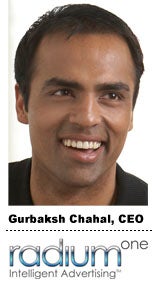 While anyone can follow a social media conversation stream through hashtags, social media ad tech provider RadiumOne is now starting to sell targeted ads off of these signifiers in real-time. The idea is to become part of consumers’ conversations as they’re taking off, not after they’ve already “trended” on Twitter or other social platforms.
While anyone can follow a social media conversation stream through hashtags, social media ad tech provider RadiumOne is now starting to sell targeted ads off of these signifiers in real-time. The idea is to become part of consumers’ conversations as they’re taking off, not after they’ve already “trended” on Twitter or other social platforms.
RadiumOne’s hashtag targeting is both a complement and an independent offering supporting the company’s “Sharegraph” data system. Among the San Francisco company’s other offerings are the url-shortener Re.Post, which places a cookie on links generated by consumers and allows for retargeting them afterward. As a programmatic player, RadiumOne claims it sees 25 billion ad impressions a day.
“Our differentiator is that we’ve created our own sharing products, which reach 700 million users,” says RadiumOne CEO Gurbaksh Chahal. “With Sharegraph and other products, we’re able to see contextually – not at the individual level – what people are sharing, who they respond to, and who they influencing. Hashtag targeting represents a next step in connecting brands and consumers in real-time.”
The timing of the announcement is meant to reflect RadiumOne’s expanding portfolio of collaborators. RadiumOne says it is among a number of “preferred partners” within the Facebook Exchange, and is planning integrations with other social platforms that might be interested in hashtag targeting technology.
The accumulation of reliable sources of data for marketers is the least obvious part of what RadiumOne’s hashtag targeting is about. For example, RadiumOne claims that social sharing platform Via.Me has roughly 11 million users a month and has been downloaded about 2 million times on Apple’s iOS and Google Android’s mobile systems. With those numbers, Chahal says, the tool has enough scale as a meaningful data source for marketers. Whenever anyone uses any of its tools, they become a clear part of one of RadiumOne’s audience segments.
Hashtags are the natural language of describing anything of interest in a social media context. The tool has wide versatility; RadiumOne is selling on a CPM basis and is aiming at everyone from direct response marketers to brand advertisers. Hashtag targeting can extend from something as specific as a new brand of Nike sneakers to movie releases, to large, impersonal events like the Super Bowl. Even holidays like Valentine’s Day, Chahal says. Brands can target anyone who hashtags the word “love.”
As all marketers realize, social in general is a great repository of data. RadiumOne says that it’s just unifying it in a way that lets advertisers generate a signal across the web, mobile, Twitter and Facebook in ways that other ad tech companies don’t.
“Part of the mystery of ad tech is that there are too many companies trying to position new ways of dynamically targeting consumers,” Chahal says. “And it all goes into a ‘black box’ and marketers have no choice but to trust it. At the end of the day, data is the difference. Being able to have first party data versus arbitraging third party data, as most ad companies do, is our main differentiator. Third party gets devalued when the recency goes away. What we’re doing is bringing new signals from the marketplace that advertisers can monetize immediately.”
What about consumers’ concerns about personal privacy and the idea of promotions becoming too intrusive within social media outlets? On the first count, Chahal points to RadiumOne’s ability to opt out of its targeting system. Secondly, the idea of better ad relevance is what he considers to be the antidote to marketing annoyance.
Lastly, there’s the issue of whether hashtags might carry additional messages that marketers might not want to be associated with. Chahal has a ready answer.
“There are semantic filters that the team has put in place to make sure that certain words, if they surround the hashtag, will be removed from the data source,” he says. “It’s taken us three months to develop. While the idea of using hashtags seems simple, because everyone uses them, being able to process data in real-time, compile an audience segment and be able to buy it through RTB takes a great deal of effort.”












